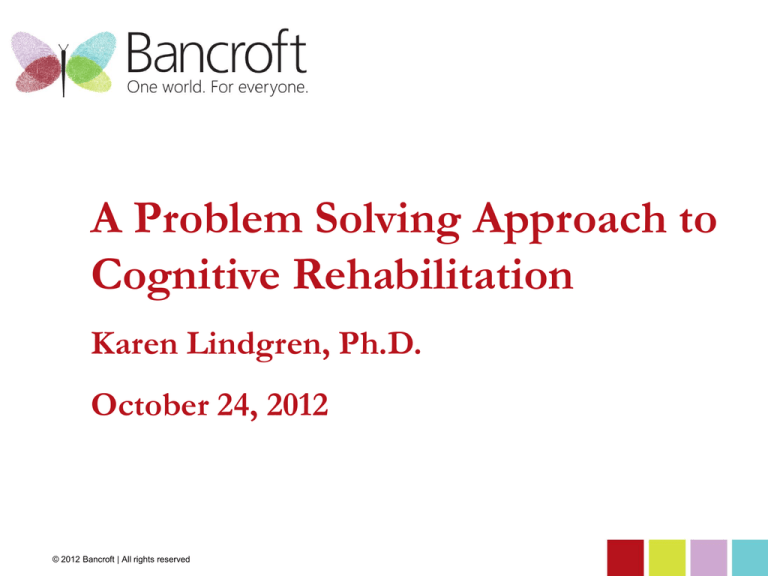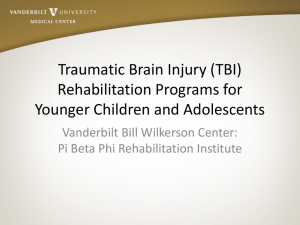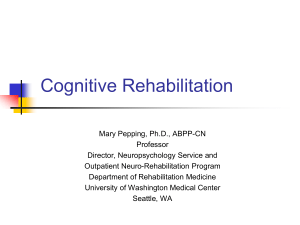
A Problem Solving Approach to
Cognitive Rehabilitation
Karen Lindgren, Ph.D.
October 24, 2012
© 2012 Bancroft | All rights reserved
Goals
• What is problem solving?
• How is problem solving relevant to community
integration?
• How do we teach problem solving skills?
2
Traumatic Brain Injury/Acquired
Brain Injury
Traumatic Brain Injury (TBI): cerebral damage
that occurs after birth, and is not directly related
to a developmental disorder or a progressive
damaging of the brain. Traumatic brain injury
refers to a specific form of acquired brain
injury (ABI) that is the result of a sudden
trauma.
Common Symptoms after TBI
Physical symptoms
• Headaches
• Fatigue
• Sleep
Cognitive symptoms
• Memory Deficits
• Word Finding Difficulty
• Concentration
• Processing speed
Emotional symptoms
• Irritability
• Depression
• Unstable or inconsistent mood
Behavioral symptoms
• Impulsiveness
• Outbursts
Cognitive Symptoms are complex
• Multiple pathways can result in similar
symptom presentation
• Lay-person language for cognitive constructs is
limited
• For example, what is meant by a “memory”
problem?
5
Cognitive constructs are complexMemory example
“Memory” complaints can result from:
environmental distractions/emotional interference
poor attention/slowed processing
expressive/receptive language
poor encoding
poor retrieval
accelerated forgetting
poor organization/comprehension of material
(executive dysfunction)
Emotions
Emotions can become flat or amplified.
Neurological rage
Lack of inhibition
Trouble analyzing social situations
Difficulty with facial expression or tone of voice
Cognitive/Emotional/Physical
symptoms interact
Multiple or varying symptoms
Complex symptoms combine to result in
behaviors
8
Cognitive/Emotional/Physical
symptoms interact: Overload
• Common complaint in community settings
• Brought on by large crowds, lots of noise, or
information presented too quickly.
Inability to process external environment (cognitive)
Fatigue (physical)
Rise in emotions (emotional)
TBI and Quality of Life
Life satisfaction appears to steadily decline after an
individual experiences a brain injury.
Injury severity has not been found to be
significantly correlated with measures of life
satisfaction.
TBI and Quality of Life
Several variables have been shown to correlate
with life satisfaction in individuals who have
suffered TBIs.
Marital Status
Problem Solving
Executive Functioning
Executive Functioning
Executive dysfunction has been repeatedly seen
and documented in acquired brain injury, and is
reported as one of the more common
difficulties facing this population.
Executive Functioning
• Executive functioning refers to the integration
of several cognitive skills people require to
adapt to novel situations and pursue their life
goals, which includes planning, initiation, and
regulation.
• Complicated concept, involving multiple skills:
•
Integration of physical, emotional, and cognitive
Executive functioning and
outcome
• Executive dysfunction has been implicated with
poor social outcomes following a traumatic
brain injury.
• Research in rehabilitation populations has
found that poor executive functioning is
strongly correlated with poor work adjustment.
Executive functioning and
outcome
Why?
Components of executive functioning help us
understand, adapt and respond to our
environment
Promotes complex problem solving
Executive functioning: Problem
solving
Research has found a significant relationship
between problem-solving ability and various forms
of psychological well-being.
Specifically the effectiveness of one’s problem-solving
ability has been found to moderate the relationship
between stress and distress.
Executive functioning: Problem
Solving
People who have suffered TBIs face a large variety of significant
problems in their day to day life.
The cognitive skills they use to cope with problems may have
been compromised by their injury.
Poor emotional control may make it difficult for persons served to
tolerate problems long enough to generate solutions.
Deficits in executive functioning may make it difficult for persons
served to generate alternative solutions.
These symptoms increase the importance of social problemsolving skills for individuals who have suffered a TBI.
Rehabilitation of problem
solving skill
Two important components:
Rehabilitate Skill (Problem-Solving Skill)
Address social problem solving (problem
solving orientation, problem solving style)
18
Rehabilitation of problem
solving skill
Two important components:
Rehabilitate Skill (Problem-Solving Skill)
Address social problem solving (problem
solving orientation, problem solving style)
19
Cognitive rehabilitation of
executive dysfunction: problem
solving
Resources:
Edmund Haskins, Ph.D. (2012) ACRM Cognitive
Rehabilitation Manual: Translating evidence based
recommendations into practice
Sohlberg & Tukstra (2011) Optimizing Cognitive
Rehabilitation
Nezu, Nezu & D’Zurilla (2007) Solving Life’s
Problems
20
Cognitive rehabilitation of
executive dysfunction: problem
solving
BI-ISIG (Task force of ACRM) recommends:
• Metacognitive strategy training as a Practice
Standard for rehabilitation of executive
functioning after TBI
• Training in formal problem solving strategies
during post-acute rehabilitation as a Practice
Guideline
References: Cicerone, et al 2011, Haskins, et al, 2012
21
Who is appropriate for problem
solving training?
• Evaluate awareness
• Evaluate effectiveness of environmental
support vs. internalized strategies
22
What Can We Do To Help Foster
Effective Problem Solving?
• Training in Problem Orientation
Problem Solving Skill
• Training in Problem Definition
• Training in Planning/Generation of Alternatives
• Training in Decision Making
• Training in Solution Implementation
• Solution Verification or Feedback
What Can We Do To Help Foster
Effective Problem Solving?
• Training in Problem Orientation
Problem Solving Skill
• Training in Problem Definition
• Training in Planning/Generation of Alternatives
• Training in Decision Making
• Training in Solution Implementation
• Solution Verification or Feedback
Problem Solving Skill
• Well researched
• Varies in the number of steps
• Includes Key components:
• Problem Definition (Awareness)
• Planning/alternatives
• Decision making
• Implementing
• Evaluating
For example, the Goal-Plan-Do-Review method
25
Problem Solving Skill
Teach the steps in a highly structured way
Provide maximum support
Goal for client to implement independently
26
Training in Problem Definition
• Is there a problem?
•
What are the signs? Mood, feedback from others, change
in circumstances
• What is the problem?
•
Example: don’t have money
Training in Problem Definition
Example: “Don’t have money”
Skill deficit:
misplace money
impulsive with spending
poor budgeting
Interpersonal challenge:
dependent on family
Vocational concern:
need a job
28
Training in Problem Definition
Example: “Don’t have money”
Vocational concern:
need a job:
locate
apply
interview
29
Training in Problem Definition
Help To:
Seek all available facts about a problem
Describe these facts in clear and objective terms
Separating facts from assumptions
Identify obstacles or conflicts that make the
situation a problem
Set realistic goals
How?
Externalize Problems
Encourage the person served to work on problems
outside of their own mind (take notes, work problems
out on paper)
Visualize Solutions
Visualize both the implementation and results of
solutions.
Simplification
Help persons served to help break large problems
down into their smaller components
Slow-Down
Teach techniques that will help individuals tolerate
the emotional arousal associated with working
with social problems
Smiling
Yawning
Behavioral Stress Management
Deep Breathing
Guided Imagery
Progressive Muscle Relaxation
Training in Problem Definition
Use worksheet:
Date _________________
What is my goal? ____________________
33
Training in Problem Definition
Use worksheet:
Date 10/24/12
What is my goal? To obtain a part time job 10-15
hours per week
34
Training in Problem Definition
Use worksheet:
Date 10/24/12
What is my goal? To reduce my spending by 25$
per week
35
Training in Problem Definition
Use worksheet:
Date 10/24/12
What is my goal? To ask my sister to give me 25$
per week
36
Training in Planning
Should be taught to expand their perceived
options and to defer judgment.
Training in Planning
• What are my options?
• What are my resources?
• What are my barriers?
Do I need to change my goal?
38
Training in Decision Making
Maximize positive consequences and minimizes
negative consequences.
Training in Decision Making
Which solution is best?
• What is most important?
• No solution is perfect
• Pros and cons list
•
40
Consider outcomes, resource utilization, ease of
implementation, effects of errors
Training in Decision Making
Pros
Cons
41
working
independent
meet people
functional/career
fatigue
costs associated
mobility concerns
less rehab focus
asking
easy to try
focus on rehab
dependency
Training in Decision Making
Utilize a worksheet
To solve this problem, I will:
___________________________________
42
Training in Decision Making
Utilize a worksheet
To solve this problem, I will:
Ask my sister to help me by giving me
25$ per week
43
Training in Planning
How will I reach my goal?
Resources/barriers: Social, environmental,
financial, cognitive, psychological
• Plan details: Who, when, where, what
• Anticipating barriers/problems: What are backup plans? Is there a safety-net?
44
Training in Planning
Evaluation of each step
• Resources/barriers: Social, environmental,
financial, cognitive, psychological
• Plan details: Who, when, where, what
• Anticipating barriers/problems: What are backup plans? Is there a safety-net?
45
Training in Planning
Use worksheet
What is my plan? _______________
What do I need? _______________
What are the steps?
1. ________________________
2. ________________________
46
Training in Planning
Use worksheet
What is my plan? Ask my sister for 25$ per week
What do I need? Budget, planner, bank statement
What are the steps?
1. _ask to meet with sister (evening preferred)
2. present budget and problem with expenses
exceeding income
47
Training in Planning
Go beyond the worksheet
What are the steps?
1. ________________________
At each step, identify resources, challenges, safetynet
Specify support to be given
Make a “larger” plan- how does this plan fit into
the rehabilitation goal?
48
Training in Planning
Go beyond the worksheet
What are the steps?
1. ask to meet with sister (evening preferred)
identify resources, challenges, safety-net: plan a
meal or snacks? Ask staff for support? Role
play? Challenges: sister busy/preoccupied
Specify support to be given
Make a “larger” plan- how does this plan fit into
the rehabilitation goal?
49
Training in Solution
Implementation and Verification
• Occurs at each step
• Proceed as slowly as implementation will allow
• Increase mindfulness of each step (e.g., what I
am doing? How am I feeling?)
• Seek feedback
• Are changes needed?
Training in Solution
Implementation and Verification
Expanded concepts of did the plan “work”:
• What worked?
• What didn’t work?
• How did I do? (Expand this concept)
• Teaching opportunity for meta-cognition- track
barriers to effective problem solving
Training in Solution
Implementation and Verification
Worksheet:
How did I do? (utilize rating scale, not “all or
nothing”)
How did I feel?
What did I do well?
What would I change? (internal as well as external)
What Can We Do To Help Foster
Effective Problem Solving?
• Training in Problem Orientation
Problem Solving Skill
• Training in Problem Definition
• Training in Planning/Generation of Alternatives
• Training in Decision Making
• Training in Solution Implementation
• Solution Verification or Feedback
Walk Client through process
•
•
•
•
•
•
Implement consistently, every time
Use written work sheets
Use memorization of steps
Apply to new, real situations
Apply to therapeutic, constructed situations
Identify client strengths and challenges: metacognition
54
Implement, implement,
implement
• Virtually any situation is appropriate for
problem solving skill development
• Consider targeting one area at a time:
•
•
•
55
Medical
Vocational
Budgeting
Implement, implement,
implement
• Target in session first
•
•
•
Teach the steps
Apply to real situations with 1:1 support
Apply to modified situations with 1:1 support
• Support out of session with maximum
support
56
Implement, implement,
implement
• In community situations, fade support, not
focus
• Gradual fade
•
•
•
57
Preset for steps, potential problems
Encourage review each step
Develop strategies to address related cognitive challenges
(e.g., internal/external strategies for memory)
For Us
As professionals, we to should attempt to utilize
many of the same problem solving strategies when
faced with challenging problems from persons
served.
Our Mission
To ensure that every person is given opportunities for lifelong learning
and fulfillment.
We do this by altering perceptions, and by supporting those with
intellectual and developmental challenges and acquired brain injuries in
achieving their life goals as valued and respected members of our world.
Our Vision
By 2014 our distinct ability to deliver high quality individualized services in
modern living, learning and working environments will exceed stakeholder
expectations and secure Bancroft as the region’s elite provider of services to
people with intellectual and developmental disabilities and brain injuries.
Our Core Values
Responsible Empathetic Supportive Passionate Empowered Committed Trustworthy
RESPECT
59





